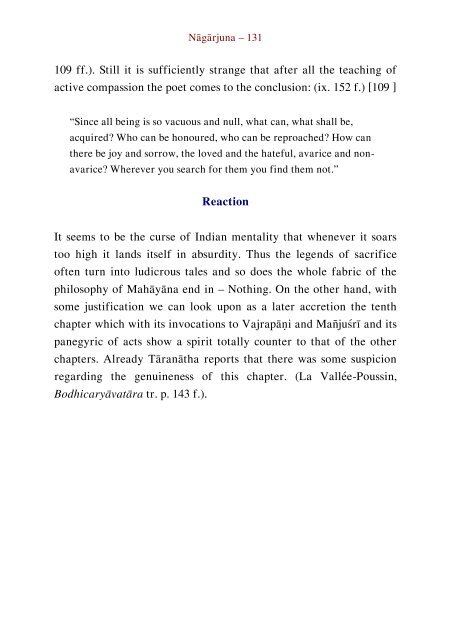Literary History of Sanskrit Buddhism
A study by J. K. Nariman of Sanskrit Buddhism from the Early Buddhist Tradition up to the Mahayana texts proper.
A study by J. K. Nariman of Sanskrit Buddhism from the Early Buddhist Tradition up to the Mahayana texts proper.
Create successful ePaper yourself
Turn your PDF publications into a flip-book with our unique Google optimized e-Paper software.
Nāgārjuna – 131<br />
109 ff.). Still it is sufficiently strange that after all the teaching <strong>of</strong><br />
active compassion the poet comes to the conclusion: (ix. 152 f.) [109 ]<br />
“Since all being is so vacuous and null, what can, what shall be,<br />
acquired? Who can be honoured, who can be reproached? How can<br />
there be joy and sorrow, the loved and the hateful, avarice and nonavarice?<br />
Wherever you search for them you find them not.”<br />
Reaction<br />
It seems to be the curse <strong>of</strong> Indian mentality that whenever it soars<br />
too high it lands itself in absurdity. Thus the legends <strong>of</strong> sacrifice<br />
<strong>of</strong>ten turn into ludicrous tales and so does the whole fabric <strong>of</strong> the<br />
philosophy <strong>of</strong> Mahāyāna end in – Nothing. On the other hand, with<br />
some justification we can look upon as a later accretion the tenth<br />
chapter which with its invocations to Vajrapāṇi and Mañjuśrī and its<br />
panegyric <strong>of</strong> acts show a spirit totally counter to that <strong>of</strong> the other<br />
chapters. Already Tāranātha reports that there was some suspicion<br />
regarding the genuineness <strong>of</strong> this chapter. (La Vallée-Poussin,<br />
Bodhicaryāvatāra tr. p. 143 f.).


















